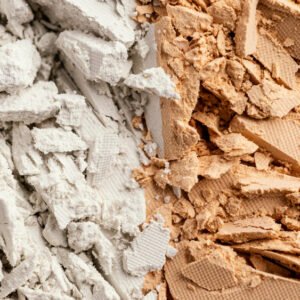In the construction and environmental engineering industries, geomembranes and geosynthetic clay liners (GCLs) are widely used materials for containment and barrier systems. While both serve similar purposes, they differ significantly in composition, properties, and applications. This comprehensive guide explores the differences between geomembranes and geosynthetic clay liners, helping you understand their unique advantages and applications.
What is a Geomembrane?
Geomembranes are impermeable liners made from synthetic polymers, primarily designed to act as barriers for liquids or gases. They are widely used in landfills, reservoirs, and wastewater treatment facilities to prevent contamination and leakage.
Key Features of Geomembranes:
- Material: Typically made of high-density polyethylene (HDPE), low-density polyethylene (LDPE), or polyvinyl chloride (PVC).
- Functionality: Provides a strong, flexible, and durable barrier.
- Thickness: Ranges from 0.5 mm to 3 mm, depending on the application.
- Durability: Resistant to UV radiation, chemicals, and punctures.
Applications of Geomembranes:
- Landfill Liners: To contain waste and prevent leachate infiltration.
- Pond Liners: Used in aquaculture and irrigation.
- Mining Operations: Prevents contamination in tailings storage facilities.
- Wastewater Treatment Plants: Ensures no leakage from treatment tanks.
- Tunnels and Underground Structures: Acts as a waterproof barrier to prevent seepage.
What is a Geosynthetic Clay Liner?
Geosynthetic clay liners (GCLs) are engineered barriers that combine bentonite clay with geotextiles or geomembranes. The bentonite clay’s natural swelling properties create a low-permeability barrier when hydrated.
Key Features of GCLs:
- Material: A blend of bentonite clay and synthetic materials.
- Functionality: Forms a self-sealing barrier when exposed to moisture.
- Thickness: Typically thinner than geomembranes.
- Eco-Friendly: Utilizes natural clay for containment.
Explore more about geosynthetic clay liners.
Applications of GCLs:
- Landfills: Used as a secondary containment layer beneath geomembranes.
- Canals: Prevents water seepage in irrigation systems.
- Environmental Remediation: Containment of hazardous materials.
- Reservoir Liners: Ideal for creating watertight reservoirs.
- Lagoon Sealing: Used in wastewater treatment lagoons to prevent leakage.
Key Differences Between Geomembranes and GCLs
Composition:
Geomembranes are purely synthetic and made from polymers, while GCLs are a combination of natural bentonite clay and synthetic layers.
Permeability:
Geomembranes provide a completely impermeable barrier, whereas GCLs have a very low permeability due to the swelling properties of bentonite clay.
Installation:
- Geomembranes: Require skilled labor and specialized equipment for seaming and installation.
- GCLs: Easier to install with fewer labor requirements.
Cost:
GCLs are generally more cost-effective than geomembranes, particularly in projects requiring extensive coverage.
Durability:
Geomembranes are more resistant to extreme environmental conditions, chemicals, and mechanical damage compared to GCLs.
Weight and Transportation:
GCLs are lighter and easier to transport compared to thicker geomembranes, which may require heavy equipment for handling.
Advantages of Geomembranes
- High Impermeability: Prevents any liquid or gas infiltration.
- Durability: Long-lasting and resistant to harsh environments.
- Versatility: Suitable for a wide range of applications.
- Chemical Resistance: Performs well in chemically aggressive environments.
Limitations:
- Higher initial cost.
- Requires expert installation.
Advantages of Geosynthetic Clay Liners
- Eco-Friendly: Made from natural bentonite clay, which is biodegradable.
- Self-Sealing: Bentonite clay swells to seal small punctures or cracks.
- Cost-Effective: Lower installation and material costs.
- Ease of Installation: Requires less specialized equipment.
Limitations:
- Limited resistance to extreme chemical exposure.
- Requires hydration for optimal performance.
- Not ideal for high-pressure containment without additional layers.
Applications in Combination
In many projects, geomembranes and GCLs are used together to create a composite liner system. This combination leverages the strengths of both materials: the impermeability of geomembranes and the self-sealing properties of GCLs.
For instance:
- Landfill Lining Systems: Geomembranes act as the primary barrier, while GCLs serve as a secondary containment layer.
- Reservoir Construction: Combined systems ensure maximum leakage prevention.
Environmental Considerations
- Geomembranes: While highly durable, they are not biodegradable. Recycling is an option to reduce environmental impact.
- GCLs: Utilize natural clay, making them a more sustainable option. However, their long-term effectiveness depends on consistent hydration.
Learn about bentonite manufacturers in India and the benefits of bentonite for sustainable solutions.
Maintenance and Longevity
Geomembranes:
- Require periodic inspections to detect punctures or seam failures.
- Resistant to UV degradation when buried.
- Lifespan can exceed 20 years with proper installation and care.
GCLs:
- Minimal maintenance is needed, provided hydration is consistent.
- Performance depends on environmental conditions and protective layers.
- Expected lifespan ranges between 15-30 years depending on usage.
How to Choose the Right Material
When selecting between geomembranes and GCLs, consider the following factors:
- Project Requirements: If absolute impermeability is crucial, geomembranes are preferred. For cost-sensitive projects, GCLs are a better option.
- Environmental Conditions: Geomembranes perform better in chemically aggressive environments, while GCLs are ideal for areas with high water tables.
- Budget: GCLs are more economical but may require additional measures for long-term effectiveness.
- Transportation and Handling: For remote sites, the lighter weight of GCLs could be an advantage.
Conclusion
Geomembranes and geosynthetic clay liners are essential materials for modern containment systems. While geomembranes offer superior durability and impermeability, GCLs provide a cost-effective and eco-friendly alternative. In some cases, using both materials together creates an optimal barrier system, maximizing performance and safety.
By understanding the differences and applications of these materials, you can make an informed decision tailored to your project’s needs. For high-quality bentonite products, visit CMS Industries.







